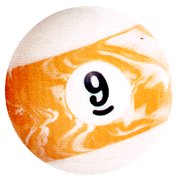9 balls yet again...
 Ok lets revisit the 9 ball question again - only this time lets make it a tricky - we do not know if the faulty ball is heavier or lighter. So how many weighings are required to find out the faulty one (minimum # of weighings) and, and can you find out if the faulty one is lighter or heavier?
Ok lets revisit the 9 ball question again - only this time lets make it a tricky - we do not know if the faulty ball is heavier or lighter. So how many weighings are required to find out the faulty one (minimum # of weighings) and, and can you find out if the faulty one is lighter or heavier?Level: Medium to Hard

6 Comments:
Number of weighings required in this case : 3. Yes, you can find out if the faulty ball is lighter or heavier.
This was my earlier answer :
Separate the balls into grids of 3.
A) WEIGH ( 123 ) AGAINST ( 456 )
If equal go to step ( B )
If ( 123 ) Heavier go to step ( C )
If ( 456 ) Heavier go to step ( D )
B) WEIGH ( 7 ) AGAINST ( 8 )
If equal, BALL 9 is the HEAVY one
If ( 7 ) heavier, BALL 7 is the HEAVY one
If ( 8 ) heavier, BALL 8 is the HEAVY one
C) WEIGH ( 1 ) AGAINST ( 2 )
If equal, BALL 3 is the HEAVY one
If ( 1 ) heavier, BALL 1 is the HEAVY one
If ( 2 ) heavier, BALL 2 is the HEAVY one
D) WEIGH ( 4 ) AGAINST ( 5 )
If equal, BALL 6 is the HEAVY one
If ( 4 ) heavier, BALL 4 is the HEAVY one
If ( 5 ) heavier, BALL 5 is the HEAVY one
To modify the logic to match this scenario :
when you weigh (123) against (456); you find one of them is either heavy/ light. You take either of the sets and weigh them against (789). If they are equal, the set kept aside is faulty, if they are unequal -- you choose the set that repeated trend for heavy/ light against your first weigh.
Continue with the same logic for the third weigh among the 3 balls !
3 weighs
Split into 3 groups of 3 each
1 2 3
weigh 1 against 2
Equal
1 heavier than 2
2 heavier than 1
weigh 1 against 3
1 heavier than 3
3 heavier than 1
If
1 heavier than 2 and 1 heavier than 3, ball is heavy and in group 1
If
1 heavier than 2 and 3 heavier than 1, then 1,2 & 3 are all unequal. So this case cannot arise
If 2 heavier than 1 and 1 heavier than 3,then 1,2 & 3 are all unequal. So this case cannot arise
If 2 heavier than 1 and 3 heavier than 1, ball is light and in group 1
Once the group and type is identified, weigh 2 balls within the group.
If equal, then 3rd ball is heavier / lighter as determined after the first 2 weighs
If unequal, based on heavier / lighter as determined after the first 2 weighs, we know which ball is defective
What happens if the (123) weighed against (456) is neither heavy nor light, it is equal?
I understand your logic, just was wondering if someone reads it, they might get this question in the head.
But BINGO, you hit it right on the spot. I'm wondering if I should close the comments for this or let others try a crack and comment on it. Excellent! Looks like I have to do some digging to find some cranky puzzles that will take some time. While I do that take a crack at the king's problem posted yesterday. Good one!
Ajit, You got it man, missed a few minutes before Kala got it, but both of you good job!
How is everyone liking it so far?
the same question came to my mind... what if Set1 = Set2?
if Set1 = Set2 then u know the faulty ball is in Set3 and u can use the remaining 2 weighings to find it.
i agree with the others that 3 is in the number of weighings :)
Excellent folks! Good thinking and good response. So let me close this entry for any more solution comments. This puzzle is SOLVED!
Subscribe to Post Comments [Atom]
<< Home